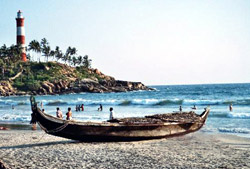Kovalam, a small town located 16km from Thiruvanathapuram is famous for its beautiful beaches. Its sandy beaches are lined with palm-fringed lagoons and rocky coves. Kovalam with its unique and wonderful beaches is a sheltered bay and is endowed with unusual natural beauty. The Arabian sea coast at many places is lined with beautiful patches of coral reefs. An hours drive from the capital, it is the most famous south Indian beach, popular for sunbathing.
It was during the 1930`s, that the potentiality of Kovalam beach as a tourist destination was discovered by the European guests of the then `Travancore` kingdom. But the real fame as an ideal beach resort was won later for the Kovalam beach in the early seventies with the arrival of masses of `Hippys`. In the seventies Kovalam became a hippy idyll, a fishing village providing fresh fish, fruit and toddy (coconut bear) nestling a picture perfect tropical beach. Later it developed into a laid back tourist hangout with a few basic but comfortable lodges and makeshift restaurants. But today this tiny beach is ferrying thousands of tourists from all around the world and has a wide range of accommodation for the budget as well as luxury tourists.
 Kovalam consists of three adjacent coconut palm fringed crescent beaches separated by rocky promontories. The southern most beach, marked by a prominent red and white striped Light House, known as the Light house beach, is the most popular of the three. It is lined with cafes/restaurants serving delicious seafood especially prawns and lobsters, bars and vendors selling clothes, crafts, carpets, fruits etc. Further south beyond the light house, is the small village of Vizhinjam. Vizhinjam, scarcely visited by tourists is a major centre for fishing. It has a beach of its own.
Kovalam consists of three adjacent coconut palm fringed crescent beaches separated by rocky promontories. The southern most beach, marked by a prominent red and white striped Light House, known as the Light house beach, is the most popular of the three. It is lined with cafes/restaurants serving delicious seafood especially prawns and lobsters, bars and vendors selling clothes, crafts, carpets, fruits etc. Further south beyond the light house, is the small village of Vizhinjam. Vizhinjam, scarcely visited by tourists is a major centre for fishing. It has a beach of its own.
The northernmost beach is the Samudra, dotted with traditional fishing boats and is least affected by the changing times. In between lies the Hawah or the Eve`s beach. North of the Eve`s beach on a rocky promontory lies the award winning resort, the Ashoka beach resort which divide the beaches into north and south sections. The resort has its own small section of private beach and provides windsurfing and sailing boat facilities. Its a 15min. walk between the Ashoka and the Light house.
 The beaches are generally safe and clean. The best season is from December to March. There are life guard patrols on the beach, but you still need to be careful when swimming. It is safest to swim between the flags in the area patrolled by the life guards. Besides swimming and sunbathing, the natural bay is ideal for kayaking, surfing and skiing. Surfboards and boogie boards can be hired on the Kovalam beach. Marine Angling for deep-sea fishing is also available at the beach. The sunrise and sun set cruises in country rafts or on logs of lashed woods on catamarans, provided by local fishermen are quite popular.
The beaches are generally safe and clean. The best season is from December to March. There are life guard patrols on the beach, but you still need to be careful when swimming. It is safest to swim between the flags in the area patrolled by the life guards. Besides swimming and sunbathing, the natural bay is ideal for kayaking, surfing and skiing. Surfboards and boogie boards can be hired on the Kovalam beach. Marine Angling for deep-sea fishing is also available at the beach. The sunrise and sun set cruises in country rafts or on logs of lashed woods on catamarans, provided by local fishermen are quite popular.
Beyond the season from between April and October the powerful Arabian Sea can roughen with swells of up to 6m. From May the sea level rises removing the beach completely in places and swimming can become very dangerous.
Kovalam is also a centre for the traditional Ayurvedic treatment. Many hotels offer complete health and revitalization packages. Apart from Oil massages, intensive treatments that last up to 21 days including special diet`s and daily massages are offered. Yoga schools offering meditation and yoga classes, are also plenty in and around Kovalam beach. Cultural programmes at the beach include performances of the traditional Kerala art form, Kathakali and ethnic martial art, Kalarippayattu.
Getting There
By Air
Nearest Airport is Thiruvananthapuram (16 km from Kovalam)
By Rail
Nearest Rail head is at Thiruvananthapuram (16km from Kovalam)
By Road
Kovalam can be reached by direct and regular bus services from Thiruvananthapuram. Buses also link the place from Ernakulam, Kanyakumari and Periyar wildlife sanctuary. At Kovalam, the main bus stand is at the entrance of the Ashoka hotel.
Best time to visit
Being near the sea makes Kovalam really a year-round destination weather-wise. The actual season is from September to March. The prices shoot up during the Christmas-New Year week as do the number of tourists, so it might be wise to avoid this period.



















